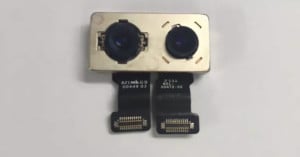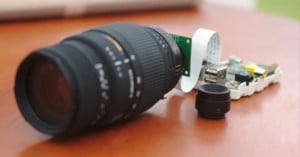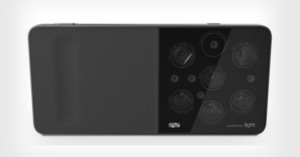
The iPhone 13 Will Be Thicker and Camera Bump Larger: Report
A new report alleges that the iPhone 13 will be slightly thicker than the iPhone 12 and feature a camera bump that will grow in size but protrude outwards less than current models.

A new report alleges that the iPhone 13 will be slightly thicker than the iPhone 12 and feature a camera bump that will grow in size but protrude outwards less than current models.

Apple looks set to beef up the iPhone camera in various ways over the next couple of years. New leaks are revealing plans for an even larger camera module on the back and a massive 48MP image sensor within.

Reports emerged recently that the iPhone 12's camera can't be repaired well by third-party repair shops -- even swapping it for a genuine Apple camera module causes functionality issues. Now it seems Apple may soon officially warn iPhone owners when their device has a non-genuine camera.

After teasing the tech in an ad earlier this week, smartphone maker Vivo has finally revealed details about the "micro-cloud gimbal" stabilization that will be built into the camera on the upcoming X50 Pro. Based on the demos, it looks to be quite a breakthrough.

Raspberry Pi just upped its camera game in a big way. The charity and single-board computer maker has just released the so-called 'High Quality Camera'—a 12.3MP camera module complete with an interchangeable lens mount... all for just $50.

iFixit has finished its teardown of Apple's new iPhone SE, and one of the main revelations is a disappointing one for smartphone photographers: the new phone does NOT use the camera from the iPhone XR. Instead, Apple is using a module that is basically identical to the one in the iPhone 8.

Oppo is teasing an innovative new smartphone camera system it has created: one that offers a 10x optical "lossless" zoom. The latest reports say the module is already in mass production and the first phone packing it will be out within months.

2019 may be a year in which the cameras on the backs of phones become bigger and more numerous. Apple is reportedly getting in on the camera count war by increasing the number of rear cameras to three and significantly expanding the size of the module.

JerryRigEverything just published this 7-minute teardown video of the Samsung Galaxy S9, and one of the interesting things it reveals is the mechanical workings of the DxOMark-leading camera, which is the first smartphone camera to feature a variable aperture.

Google's new Pixel 2 phones boast the best smartphone camera ever tested by DxOMark. In this 9-minute video by Nat and Friends, learn how Google created this bar-raising camera. The video includes a number of interesting interviews with the Pixel 2 team.

Qualcomm thinks dual cameras are the future of smartphone photography, and they'd like to get on the train before it picks up too much steam. Enter 'Clear Sight,' the company's new dual camera module that's probably gonna start popping up in smartphones all over the place.

Nothing is "confirmed" before the manufacturer says so, but a new Apple leak is being hailed as "confirmation" that Apple is going to put Optical Image Stabilization into the 4.7-inch iPhone 7, something the smaller iPhone 6 and iPhone 6s both lack.

Word that Hasselblad is making a powerful camera attachment for Lenovo's Motorola Moto Z phones has been in the rumor mill for months, but today we're getting our first substantial look at the unconfirmed MotoMod.

Okay Google, eject the camera.
Five little words followed by a small 'pop' from the prototype phone sitting on the table in front of him, and Google's Rafa Camargo made the the crowd at the Google I/O developer conference go wild.

We've shared a number of do-it-yourself camera projects involving Raspberry Pi in the past. If you're interested in trying your hand at one, it's now even cheaper: the ultra affordable $5 Raspberry Pi Zero now has a camera connector.

The 5MP Omnivision camera module was the Raspberry Pi's very first add-on, but in the three years since it was release it hasn't gotten a single update... that is, until today. The Rasberri Pi Foundation has officially announced the arrival of a new and improved Sony module (actually two), and it won't cost you a penny more than the last one.

In addition to announcing a new iPhone and iPad Pro yesterday, Apple also introduced Liam, a recycling robot that it uses to automatically salvage recyclable materials from old, defunct iPhones.

The iPhone 7 Plus is rumored to have a powerful dual camera module as its superior feature over the standard iPhone 7, and now the first photos of that component may have surfaced on the Web.

I always tell people that the problem with phone cameras is the lenses. This isn't a thesis that is easy to test because you can't swap the lens on a phone without destroying it. But now the Raspberry Pi has a camera module that's basically a phone camera sensor. It's also easy to get an Raspberry Pi camera module with a C mount so you can easily change lenses.
I also own a Nikon DSLR camera for which I have a few lenses, so I bought a C mount to F mount (Nikon) lens adapter so I can use the big DSLR lenses with the Raspberry Pi camera

There's a stealthy startup in Silicon Valley that's working to revolutionize photography. It's called Light, and one of its goals is putting 52-megapixel cameras in smartphones by next year.

A recent patent filing by Apple suggests that the company is working on a new periscope-style camera module design that offers better optical stabilization with the use of mirrors.

With each passing day, it seems as though light field photography (and its imitators) is becoming more and more ubiquitous. Patents here, rumors there, it’s a conglomeration of what is very likely the next frontier in photography.
And this past week, Pelican Images published a collection of online 3D viewer images captured with its thin light field camera that might be making its way into mobile devices soon.

Samsung seems to be hard at work making sure that smartphone camera quality continues to improve in leaps and bounds. In addition to debuting ISOCELL technology a couple of weeks ago, the company has now announced a new smartphone camera module that will offer twice the optical image stabilization of anything on the market, while also capturing better photos in low light.

It's been 10 months since Toshiba was said to have been developing a tiny camera module that would bring Lytro-style refocusing to smartphones and tablets, but the company only just announced something official.

Raspberry Pi's new Camera Module is starting to hit store shelves, and we're starting to see some interesting photo experiments being done with the simple programmable camera kit.
High altitude ballooning enthusiast Dave Akerman recently decided to send his $25 module up to the edges of space to snap photographs of Earth and beam images back during its flight.

Lytro is seeing more and more competition these days, as more and more companies are jumping into the "snap now, focus later" game. There are now apps that mimic the technology, and companies like Toshiba are working on building Lytro-style smartphone camera modules.
Lytro's latest challenger may be quite a formidable foe: it appears that Nokia has invested in Pelican Imaging, another startup that's working on building Lytro-style smartphone camera arrays.

Apple's next iPhone release may come with enticing upgrades to the phone's camera, including a 12-megapixel sensor, improved low-light capabilities, and HDR photography.